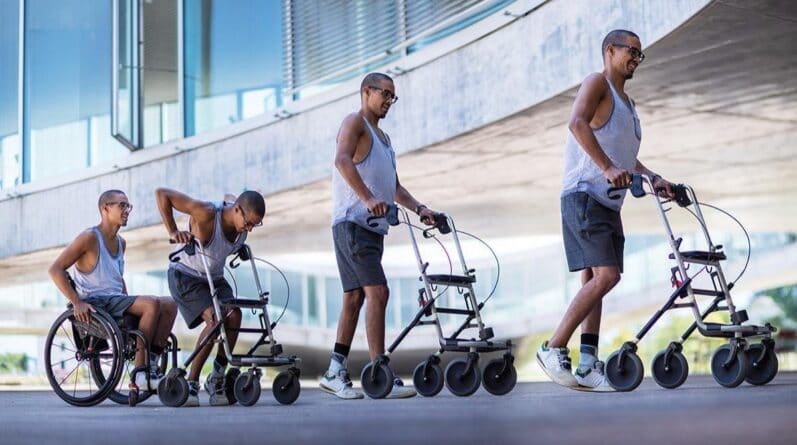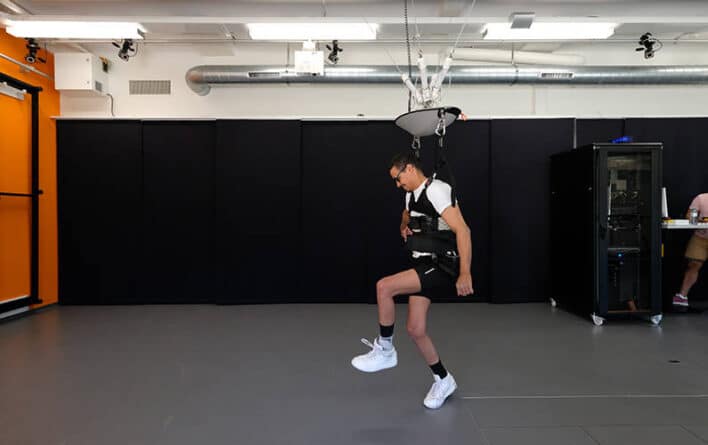
Swiss scientists have developed a device that stimulates the spinal cord. Thanks to it, paralyzed people will be able to get back on their feet within a day after surgery. Read today in USA.ONE magazine:
An implant will allow paralyzed people to walk again
This is a real breakthrough in medicine!
An implant for paralyzed people has been created in Switzerland 
In 2017, Italian Michele Roccati (pictured) was injured in a motorcycle accident. His spinal cord was damaged and the man lost the ability to walk. After surgery on the spinal cord, into which surgeons implanted an electrode, Roccati began standing again, showering without a chair, and even walking around the city with a walker.
"I am free and can walk wherever I want!& #34; — Michelle rejoices.
The paralyzed Italian was one of three men, aged 29 to 41, to take part in the STIMO clinical trial, led by Dr Jocelyn Bloch from the University of Lausanne and Grégoire Cortin from the Federal Institute of Technology in Switzerland. Patients had 16-electrode implants implanted in the epidural space between the vertebrae and the membrane of the spinal cord. The current to the electrodes comes from a stimulator sewn under the skin of the abdomen.
All those operated on were completely paralyzed, and two of them lost sensitivity due to their injuries. But thanks to the devices, doctors were able to use a tablet computer to receive electrical impulses sent to epidural electrodes through the implant to activate patients' muscles. Soon after the operation, the men began to move and take their first steps on a treadmill a day after installation of the implant.
"This is an extremely emotional moment, because patients realize that they can walk again," ; — said Bloch.
Doctors have been studying electrical stimulation of the spinal cord for 30 years. Initially, the technology was supposed to relieve pain, but now it helps to get back on your feet. Previous research from the University of Louisville found that completely paralyzed people could walk again within a few months of rehabilitation using electrical spinal cord stimulation. Just one week after surgery with STIMO implantation, all three patients were able to walk independently using body weight support from suspension belts and bars.
"Rehabilitation is still important, but for the first time we have immediate results. Paralyzed people, deprived of sensitivity, were able to stand and walk," — Cortin shared.

According to neurosurgeon Nandan Lad from Duke University, the developed device will make it possible to treat tens of thousands of patients with spinal cord injury who have no other way to get back on their feet. Lad was not involved in the new study but is leading it in the US. A new set of electrodes gives access to a wider area of the spinal cord to stimulate the muscles of the legs and body. Thanks to the optimal placement of the device and the delivery of impulses, muscle activity is achieved. According to Lad, precise electrode placement is the key to quickly stimulating the right muscle groups.
The STIMO trial involves a new way to maintain movement. A synchronized sequence of stimulations is generated using motor responses to different electrical discharges, triggers movement and mimics the natural activation pattern of the muscles needed for walking. Department of Neurological Surgery professor Susan Harkema, who led the Louisville study, says the two types of stimulation can generate movement patterns through a patient's spine and some functions are preserved even in complete paralysis.
The STIMO implant will allow people with spinal cord injuries to walk, but only while it is turned on. Without impulses and stimulation, movement is impossible. It needs to be replaced every 9 years, but the electrodes can remain in place for life. Thanks to training, patients will be able to increase endurance and expand the range of activities. After surgery, they will receive 1-2 hours of physical therapy 4 times a week. 3-4 months of regular training allowed one of the participants to stand for 2 hours straight, and the other to walk 500 meters independently. The third was able to climb the stairs.
The tablet used in the study is equipped with special encoded programs, including swimming, walking and standing. The more patients train, the more they achieve. Cortin and Bloch plan to make the implant more comfortable for daily use. For example, integrate the program with smartphones or smart watches. After this, the team plans to conduct a large clinical trial in the United States. It will take 3-4 years for the technology to become commercially available. The FDA has already called the device a "breakthrough in medicine" and wants to quickly implement the technology into life.
Did you like the news? Share it with your friends on social networks and don’t miss even more materials on our website!